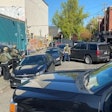Did you know that California is celebrating its 100th year of street gang influence? Believe it or not, several sates have 100-year-plus street-gang histories. So the street-gang phenomenon is not new. As we all are aware, most street-gang customs and practices are based on established tradition. Expected behaviors and customs are passed down from the older gang members to the younger ones. However, the subculture practices are also subject to current societal influences and law enforcement pressures.
Changes
Street and prison gangs have responded to these pressures in various ways. Some gangs have developed a crime specialty. The country has experienced this with gangs that specialize in car thefts, drug sales or non-violent crimes, such as fraud.
Our country's demographics are always changing. Mixed-race marriages are now common. In the past, youths with mixed-race backgrounds weren't allowed entry into street gangs that were traditionally race based. This demographic change became the impetus for a change in membership rules. Today, for some gangs, membership is not based on race and gender. Remember, this was the main reason why the 18 Street gang formed. The gang now has national and international status.
In addition to these factors, some street gangs have also been influenced by attitude and philosophical changes. Today, most street gangs base "respect" on fear. The more you fear me the more you respect me. The traditional rules of not involving innocent women and children in gang warfare are gone. For lack of a better way to say it, the "gang ethic" has changed.
The courts, corrections and law enforcement have also responded to these changes. New suppression and enforcement strategies are employed. Gang enforcement laws have been written and passed. The courts have responded by handing down more severe sentences. Corrections has been impacted by the number of new inmates and their gang affiliations.
All of these factors collectively fuel additional changes within the street-gang subculture and the impact can extend throughout the entire U.S. street-gang population.
Hybrid Hispanic Gangs
For example, most gang specialists are hardly surprised to encounter new gang behaviors or customs. For those of us who work the streets, we always expect to be surprised by what street gangsters do. However, the unexpected could be the forerunner of future gang trends. The illegal drug industry has caused some unique relationships to form between rival Hispanic gang members. Rivals in Southern California, these Hispanic gang members form alliances with each other outside of the state. Their purpose: to establish a drug business. Working together and supporting each other, they have become known as "Sueno" or "Sueno-13" gangs.
As you are aware, traditional Hispanic gangs throughout the country are turf oriented. They claim a specific geographical area with a city or county. Usually, the turf boundaries are marked by the gang graffiti. The graffiti acts like a welcome, warning or challenge, depending on whether you are a member or ally of the fang, a non-gang member living in the area or a rival gang member.
Across the country, some Hispanic gangs claim the entire city they live in as their turf. For these gangs the concept of turf is fluid, as the gang changes specific gathering locations in the city over time. These hybrid Hispanic gangs will often allow anyone, including females, to be a member.
Mobile Hispanic Gangs
Another type of gang recently encountered in Southern California has been mobile Hispanic gangs. This Hispanic gang still maintains traditional membership rules and claims specific geographical areas within the city in which members live.
In one rapidly growing Southern California city in Riverside County, homes are still in an affordable price range, the schools are good the climate is warm. The location of the city even allows for a tolerable drive to Los Angeles, San Diego and Orange Counties. There is only one Hispanic gang in the city, but it is divided into eight different cliques (sub-groups or sets). Most of the time the cliques get along with each other.
What is most unique about this gang is that members from different cliques will get together, drive into the adjacent counties and commit robberies. Then they will drive back to their city, divide the loot and return to their individual cliques. This is behavior that is very similar to what law enforcement has seen with Southeast Asian street gangs. Could this be a preview to future Hispanic gang practices? This is the first mobile Hispanic gang I have encountered.[PAGEBREAK]
Fighting Gangs
The country is well off right now. Many Americans are enjoying an unprecedented level of financial comfort. People are enjoying this level of comfort by moving into more affluent neighborhoods. Out of these affluent neighborhoods, a new type of street gang has formed. The gangs claim the entire city as their turf, but rarely, if ever will you find any graffiti in a public place. The majority of membership is made up of Caucasian males ranging from high school age to early 20s. Membership is not limited to Caucasians, mixed race and other ethnic groups are allowed.
Although hand signs are used, they are seldom flashed in public or in front of adults. In fact, membership to the gang is always denied to authority figures-like parent, teachers and police. Clothing styles may favor a certain past era, like the dress styles of the 1950s. Sometimes no particular dress style is chosen.
Secretive in their membership, only fellow students, victims and rival gang members know of their existence. This kind of gang member is versed in knowing about current gang laws and consequences of being convicted for gang-related violent crime. Concealing gang membership is not new. Across the country many gang members attempt to deny their gang affiliations to parents, police and teachers.
What makes these groups unique is their operation. The group members may go to school, be good students, hold down part-time jobs and have no prior police contacts. However, they socialize together, have a common name and engage in a pattern of gang attacks. The members in this gang can involve themselves on a part-time basis. The group is motivated to commit assaults on rival groups or randomly, as the opportunity presents itself. Sometimes victims don't know why they were attacked. Attacks can be spontaneous, such as a minor traffic incident that turns into a group attack. When mobile, the group travels in several cars or trucks.
The attacks have also occurred at parties. The gang members are not invited, but crash the party. Once there, a verbal altercation is used to justify an attack. These types of gangs are known as fighting gangs. The weapons have been fists, feet, knives, beer bottles and bats. It is usually a group attack. At times some members will act as lookouts. Sometimes, a smaller-sized member is used to bait the victim into a fight. The chosen victim is usually larger in stature and when the fight starts, the remaining members of the gang attack. The justification is to help out their friend. Victims are threatened with repeated assaults if they cooperate with the police, so there can be witness intimidation.
Investigation
These gangs have a reputation of being true to their word. This can make a case difficult to investigate. Responding officers might ask the victims and witness what was said by the attackers just before, during and after the assault. Often, the gang name is yelled out during these times. The status of the victim might also help, especially if he claims membership to another street gang. The "dis" or disrespect perspective may have been the gang motive for the attack.
If the attack occurred in a public place, like a gas station or store, check for a security video. Think search warrant! As with many gang members, homemade videos document the gang's activities, such as gang parties, use of gang hand signs, showing off hidden tattoos, claiming gang membership and gang assaults. Remember, it is the behavior that is a good indicator of gang motive and membership.
The gang has the ability to roam throughout a city or county. Members do not have to live in the same city. Normally, members don't stand out; they come from affluent areas of the community, are good students, deny membership, have no visible tattoos and often have no prior police contacts. These facts allow parents to deny their son's gang status and involvement. Nevertheless, the group is a street gang and the attacks are gang motivated. Be safe!
Al Valdez is an investigator with the Orange Co. (Calif.) District Attorney's Office and author of the book, Gangs.











